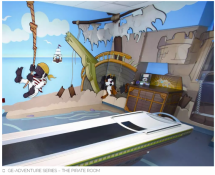Changing Experiences through Empathy – The Adventure Series
This is a case study of a team that designed an environment and game to help children who need to undergo tests using medical diagnostic machines that seemed frightening to them. The team created an environment that was fun and lighthearted, using human-centered design to do their research.
Their creation is called “The Pirate Adventure” and in this environment a visual transformation of the equipment that was available before patients are on a dock. There is a shipwreck and some sand castles in the corner. Children then work on the plank to be scanned. The Coral City Adventure in the emergency room gives children an underwater experience. It has a disco ball that makes light like bubbles around the room; children get into a yellow submarine and listen to the sound of harps whilst the procedure takes place. The Cozy Camp gives children the chance to be scanned in a specialized sleeping bag, under a starry sky in an impressive camp setting.
Some positive impacts include:
- Patient satisfaction scores went up 90 percent.
- Children do not suffer of anxiety anymore
- It makes it easier for children to hold still during the procedure what in turn prevents the doctors from having to repeat the scan
- This less need for anaesthesiologists meant more patients could get scanned each day, which heavily impacts the financial side of the equation
Source: This is Design Thinking
Date of Publication: March 25, 2019
SIMILIAR RESOURCES
Tools
Examples
- Empathy – How to Improve Your Designs by Developing Empathy for Your Target Group
- Integrating Human-Centered Design in a Multidisciplinary Effort to Address Provider Bias: The Beyond Bias Experience
- Transform/PHARE
- Barrier Analysis Questionnaires
- Design Kit for Human-Centered Design
- What is Human-Centered Design?
- Course on Human-Centered Design
- Design Kit: The Facilitator’s Guide to Teaching Human-Centered Design
- Principles of Human-Centered Design
- What Does it Take? Operational, Cultural, and Structural Ingredients Necessary to Design for Girl-Centered Care

